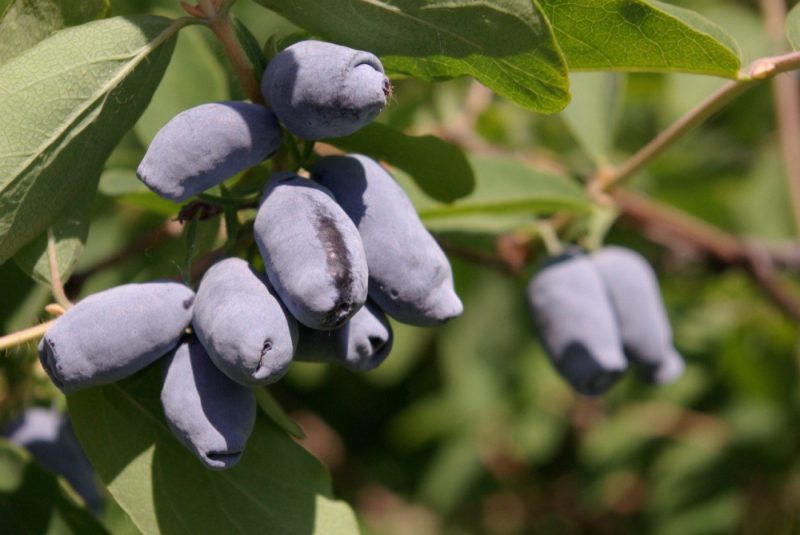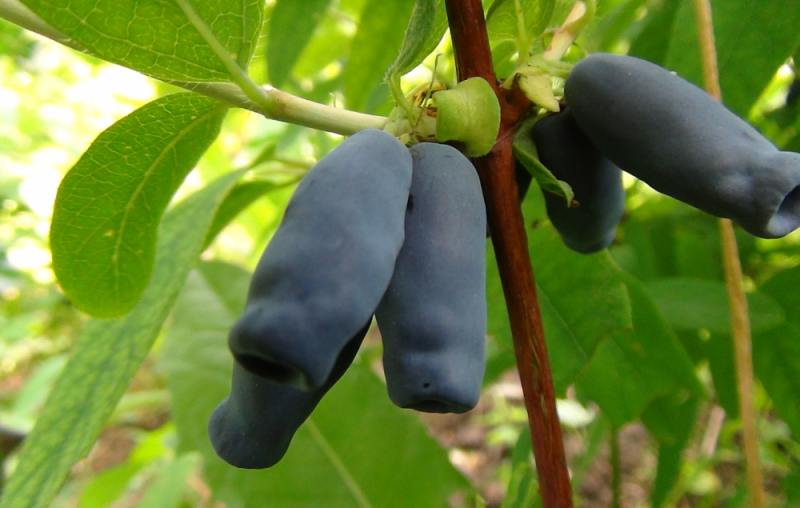Among edible varieties, Honeysuckle Cinderella has been known since 1991, when it was recommended for cultivation in Eastern and Western Siberia, in the Urals. Received in 1974 from Kamchatka honeysuckle.
Material Content:
Description of honeysuckle variety "Cinderella"
In the description of the variety, you need to especially dwell on the sizes. The height of the bush is 60-70 cm. It is 2 times lower than other varieties. A dense crown made up of thin curved or erect twigs. The leaves are not small, light green, elongated oval, slightly concave.
Berries weighing from 0.7 to 1.4 g, almost 1.7 cm long. Elongated cylindrical, dark blue, almost black, covered with a skin on which a pale blue coating is present. The pulp has a soft sweet and sour taste and smell reminiscent of strawberries.
The fruits contain:
- sugar - 8.4-8.7%;
- acids - 1-1.4%;
- vitamin C - 20 mg and P - 599 mg per 100 g;
- pectin - 1.12%.
Ripening occurs from June 1 to June 22. For industrial cultivation, the variety is unpromising, because of the low height it is impossible to use berry-harvesting equipment.
Increases productivity, quality pollination and watering.
The best pollinators are recognized: Azure honeysuckle, ovary is 76% or Gerda - 40-55%.
Good pollinators: Parabelskaya, Amphora, Kamchadalka, Tomichka, Leningradsky giant.
Bad: "Berel", "Blue Spindle", "Salute".
The advantages of the variety are the wonderful taste qualities of the fruits, their rapid ripening, excellent yield, resistance to lower temperature indicators and diseases.
Disadvantages - a small amount of berries that quickly crumble, the inability to machine harvest.
Growing Features
To get good harvests, you should know some features of growing honeysuckle. The main thing is to choose the right place for landing. Suitable plot is sunny, not shaded, without drafts. The soil is preferably light, neutral. In low light, the fruits lose their sweetness, yield decreases.
Bushes quickly thicken. Thinning is required each year in early spring. If this is not done, the insects will not be able to pollinate the flowers in the inner part, and the crop will only be on the peripheral branches. It is recommended to start such pruning at 4-5 years old, not earlier.
Plants of the same variety will not bear fruit; pollinators are needed.
Outdoor landing
Honeysuckle is planted in open ground in spring. Pits are prepared in advance, measuring 40x40 cm at a distance of at least 2 meters. Before planting, it is necessary to prepare a nutrient mixture consisting of a bucket of humus and a liter of ash. Wells are shed with a pink solution of potassium permanganate for disinfection.
Then half of the nutrient mixture is poured out, seedlings are set so as not to deepen the root neck, the roots are straightened. They fill it with soil, add the remaining mixture from above. Gently ram, watered. The soil around is mulched with sawdust, straw or grass. Mulch will retain moisture and heat.
Plant care
Leaving includes the following procedures: watering, top dressing, cutting, cultivation and timely removal of weeds.
The first two years the bushes in the summer period are thoroughly watered: 2-3 buckets per plant weekly with mandatory loosening.
Loosen carefully so as not to damage the roots that are in the topsoil.
They begin to feed from the third year. Organics are bred in water: mullein 1:10, bird droppings 1:20. The proportions are observed exactly. Their violation can lead to burns of plants. Before flowering and after harvest, nitrogen fertilizers are used. In the middle of summer - potash. You can use humic preparations, they give good results.
Cut to form a crown and give an aesthetic appearance. And also this event contributes to the healing and rejuvenation of the bush. The first time it is carried out after planting. Shoots are shortened by 1/3. Subsequently, diseased, weak, dry and deformed branches are removed.
Protection against diseases and pests
The plant practically does not get sick, but under adverse weather conditions on the bushes fungal diseases can develop:
- ramulariosis is characterized by the appearance of gray-brown spots of irregular shape, with a dark stripe along the edge. It is treated with 0.2% solution of “Fundazole” or soapy water with the addition of copper sulfate in a ratio of 1:10;
- cercosporosis is expressed by small rounded dots with reddish-brown edges. In wet weather, the central part of them is covered with black coating, these are spores of the fungus. The treatment is the same as with ramulariosis;
- powdery mildew in appearance resembles a felt coating of white color. To combat it, drugs are used: Chistotsvet, Tiovit, Rayek. But above all, plant debris and dried shoots on which the fungus develops should be destroyed;
- freezing holes look like cracks in the bark, extending into the wood. Inside, saprotrophic fungi develop, which lead to the drying of the branches. Timely identification and removal of damaged shoots will save your plant. Still need to spray "Cinderella" Bordeaux liquid after flowering for prevention.
In addition to fungal infections, the appearance of viral infections in honeysuckle is possible.
The most common are:
- mottling of leaves;
- mosaic cutters.
The fight against viral diseases is reduced to the removal of the affected parts, and sometimes the entire bush to save healthy specimens.
To prevent the development of diseases, they are sprayed with Fundazole or copper sulfate before flowering.
Pests can also settle on the berry shrub. Sometimes Cinderella is struck by aphids. To destroy it, use a 0.2% solution of Aktara or Aktellik.Prevention consists in spraying with infusion of garlic, tobacco, pepper.
In addition to aphids, the following can appear:
- honeysuckle tick and scale insects. Against them use the same drugs as against aphids;
- the pseudoptera affects the berries. To combat it, Inta-Vir is used.
Regular examinations will prevent the development of diseases and pests. Preventive measures, cleaning of dry branches and leaves, thinning bushes will help for many years to feast on healthy and tasty berries.
Gardener tips
Amateur gardeners and professionals are advised to follow several rules when growing honeysuckle, then you will succeed:
- Plant bushes in a place open to sunlight. In the shade, honeysuckle grows, but bears fruit very poorly.
- Be sure to take several different varieties, this is necessary for pollination.
- When propagated by cuttings, varietal qualities deteriorate. It is better to buy seedlings in nurseries.
- Keep in mind that for the first two years, culture grows slowly.
- In frosts with high humidity shoots freeze, you need to take care of shelter.
- From berries, delicious compotes and mashed jam are obtained.
Along with this, to increase productivity, it is required to attract insects so that they pollinate flowers. These include bumblebees and bees. Arrange the bushes in a group, not in a row. Sprinkle them with sweet water as soon as flowering begins (2 tbsp. L. Sugar or honey per liter of water). If the weather is cool and windy, it is better to spray with means of "Bud" or "Ovary", which improve the formation of fruits.
During budding, you can spray a mixture of “Tsitovita” (2 ampoules) and “Zircon” (1 ampoule) onto a bucket of water.
Edible honeysuckle will not only decorate your site, but also bring a harvest of healthy vitamin fruits. Just do not forget about its features. Have a good landing!















